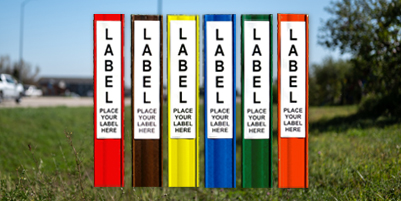Order utility line markers from ComplianceSigns today.
Colored Utility Marking Posts are Required
The American Public Works Association (APWA)/Utility Location and Coordination Council (ULCC) color code is a universal marking guide for underground facilities used in construction and engineering projects. The code helps prevent damage, accidents, and service interruptions for contractors, excavators, and others working near underground facilities.
What Do Utility Marker Colors Mean?
Locators use the APWA Uniform color code to mark underground facilities. Each color used represents a different type of utility:
Blue: Potable water
Green: Sewers, drainage facilities or other drain lines
Orange: Communication, alarm or signal lines, cables or conduits, and fiber
Pink: Temporary Survey Markings
Purple: Slurry, irrigation and reclaimed water
Red: Electric power lines, cables or conduit, and lighting cables
White: Pre-marking of the outer limits of the proposed excavation or marking the centerline and width of proposed lineal installations of buried facilities
Yellow: Gas, oil, steam, petroleum, or gaseous materials
Permanently Marking Underground Facilities:
The following recommendations shall be followed when permanently marking underground facilities:
- Markers must be clearly visible
- Marker material shall be durable in nature. (Treated Wood, Metallic, UV Resistant Plastics, etc.)
- Mark culverts if not readily visible. Mark both ends of all non-visible underground facilities
- Identify type of underground facility if not recognizable from the surface
Utility Marking Resources:
Learn about your state specific utility marking processes and laws
Annual DIRT Report analysis of damages to buried infrastructure
Best Practives Guide for damage prevention and safety
Locator White Paper with insights into improving utility locating
APWA Resource Center

